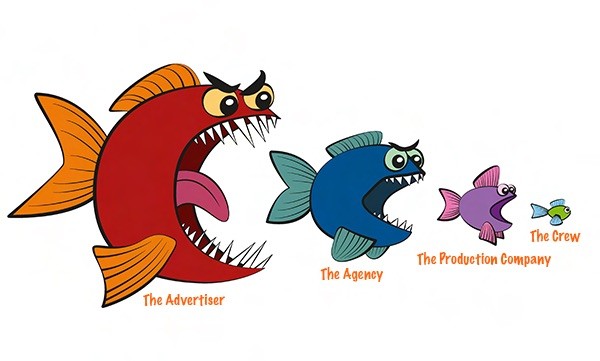Last year the ANA responded to the investigation by the Department of Justice into Agency production practices and included this in their call for greater transparency in advertiser and agency relationships.
The concern was that agencies and especially the Holding Companies that own the agency groups, were competitively tendering for advertiser commercial productions against the independent production companies in an unfair and biased manner.
Effectively it was claimed that the agencies were lining their own coffers by under cutting the independent production companies by having them tender and then providing competitive services at a lower price, effectively and unfairly squeezing them in the market.
But from our perspective of more than 30 years of industry experience, this lack of transparency exists at every level of the production process in some form and in fact all parties, from the advertiser whales down to the smallest minnows could be more transparent in the process.
The sad fact is that the people that end up ultimately suffering in this process are the smallest such as the crews that subcontract to the production companies.
Advertisers and their agencies
Lets start at the beginning and follow the money trail. The whole process starts with an advertiser wanting to produce a television commercial (or these days some video or film content).
This starts with the brief and becomes the first point where lack of transparency impacts the process. It is because very few advertisers feel comfortable providing the agency or the production company (if they are working directly with them) with a budget.
The perception is that if they provide a budget then the agency or production company will use the whole budget and perhaps then some. But here is the kicker for the lack of transparency, it can end up being incredibly inefficient and costing you a lot more by not providing it.
The budget should represent your level of investment or the value of the project. There are many ways to calculate this and we have helped many advertisers create customised methodologies to do this.
But without the budget the agency and production company have no idea how much they can spend and it is in their interest to make the creative idea as outstanding as possible (read as expensive as possible) to build their reputations. So they come back with ideas and you fall in love with one of them only to find out that when it is quoted it is going to cost you ten times more than you had budgeted.
At this stage you should drop the idea and get the agency to do the work again, this time with a budget in mind. But because the clock is often ticking and because the advertiser has fallen in love with a concept they cannot afford, the way forward is to try and get the concept delivered for a cost closer to the budget. The problem is that if these cost reductions are substantial it leads to corner cutting and compromises in the production and the quality of the final product.
In one case the agency concept, which won Link testing and the advertiser loved, was found to cost more than $1.5 mill when the advertiser’s actual budget was $300,000. The production cost was slashed though a series of decisions and significant pressure on the production company to just $650,000 (still a significant amount of money). But the resultant television commercial was never broadcast because the quality reflected so badly on the brand and the company.
In another case three days of unseasonal rain incurred weather days, which were not budgeted for the additional cost came from cutting the media budget leaving media reach below optimal performance. While the advertiser got the concept they loved it came at a significant cost that could be avoided if they were more transparent with the budget.
Agencies and the Production Companies
Agencies and their Holding Companies have for many years realised the benefits of providing production capabilities to their clients. By mounting the production within the agency, or creating a wholly owned production company they were able to capture more of the advertisers budget and the associated profit.
These agency-owned and run production companies are a legitimate alternative to the independent production companies in the market and can be ideal for particular clients and projects. The problem arises when the agency production company is not only completing with the independents, but is running the selection process as well.
But likewise the independents have been complicit in this practice, providing to the agency production department what is known in the industry as “check quotes”. These are quotes provided to the agency to create the appearance of a competitive process where the production company knows they will not win the tender, but are promised future work for compliance.
But even if the agency does not have their-own production company, the lack of transparency in the agency production process can be seen in the way the agency presents the quotes to the client for approval. Typically the agency will present a summary of the costs with around two thirds of the cost in a line item called Production House or Film Company.
Behind this cost centre is often multiple pages of production company estimate details prepared by the production house in developing their cost proposal. But it can also hide agency fees, rebates and payment. In one case the agency had inflated the production company cost on their estimate to hide thousands of dollars of un-billable agency hours. It was only once the film company cost was requested that the discrepancy was discovered.
More difficult to discover is where production rebates are provided, especially between postproduction house and production companies. But increasingly agencies are negotiating deals with postproduction houses and dub distribution companies that are billed to the client and then rebated either as cash or credits.
When decoupling (see details of this process below) postproduction for a client, who wanted to manage this direct, we were able to negotiate a 35% volume discount typical of volume rebates in market.
Production Companies and the Crews
But it is not just the clients and the agencies that lack transparency in this process, the production and film companies are also guilty. A major issue is the standard production company contract (more on this below).
It is usual that this is a fixed price estimate with no right to audit. But increasingly it contains the line “We (the production company) reserve the right to negotiate all contracts upon award”. This means that the production company reserves the right to negotiate their supplier contracts after appointment.
It is apparent that the production company is happy to charge the client full price then negotiate with the crew or suppliers and pocket the difference. Well what a surprise! What is more distressing (anecdotal evidence from the crew members contacted) is that the production houses say to those they do these deals with, it is due to the “pressure to reduce costs” coming through the agency from the clients.
So by default the advertisers who are to blame for the reduced budgets, rather than the fact that along the way the agency and the production company are holding on to more of the budget themselves. But this lack of transparency also means that in the end it is the smallest vendors in the supply chain who are paying the price for the behaviour of all those above them.
The other problem with the lack of audit rights on the production company contract is it means you rely heavily on the agency and especially the agency producer to vet the production company estimate to ensure it is fair and reasonable and that all contingencies, buffers and excesses are removed.
But what is the incentive of the agency to deliver these savings beyond bringing the cost in on budget, if there was even a budget provided in the first place? The agency wants a great job and the fear is that negotiating too hard may influence the director’s desire to take on the job. Seriously this is often quoted as a concern of the agency.
Besides the agency would prefer to have contingency allowances in the production company budget so that if they want to make changes they can request this without having to ask their client for more money or pay for it themselves. But if these contingencies are not required are they refunded to the client or do they go straight to the bottom line of the production house?
The little guy pays for the lack of transparency
So the advertiser often lacks transparency in the budget they are willing to spend and what they expect for the cost. Agencies often lack transparency in their effort to maximise their share of the client budget and recoup revenue they have lost in other areas of their remuneration. Film and production companies lack transparency in the way they quote their services and the terms and conditions in their standard industry agreements that preclude the ability to audit. But who is the one that misses out?
Well certainly advertisers are not always getting value for their production budget but it is the smaller vendors and suppliers to the production industry, mainly the crew, who are paying the price. Often overtime is negotiated out of their deals, while it is charged to the advertisers.
Or they are asked to work three days for the price of two and so on. These are often sole traders, partnerships and small companies who are the life-blood of the production industry. This is the talent that makes the film and television industry function and thrive.
It is sad that they feel that the reason they believe they are being screwed is because of the stinginess of the advertisers. At the other end the advertisers feel like they are being overcharged by their agencies. Perhaps the problem is that the agency is providing concept and ideas the advertiser cannot afford? Perhaps the advertiser is wasting the agency’s time playing guess my budget? Or perhaps the problem is that everyone is out for themselves?
But change is coming and we are seeing an alternative to the current structure where the advertiser is being put directly in contact with the large number of small and talented film and television production talents, effectively eliminating the intermediaries and providing access to a much broader talent and skill base than even the agencies can access.
How to bring transparency back to production
There are steps that advertisers can take to make their film and video productions more cost effective including:
-
Decouple production
This is effectively implementing direct contractual relationships with the various suppliers previously managed by your agency. While this has been very popular overseas, in the Australian market it is hotly, if often anonymously, contested. The last time we helped a client with this process it ended with this misleading and sensationalist article in the trade media based on anonymous accusations and co-ordinated by the industry body representing production companies and the agencies.
But it is possible to decouple these arrangements if the effort justifies the rewards and it is increasingly popular as advertisers are making more video content for their marketing strategy than the occasional television commercial.
-
Upgrade production contracts
As mentioned above, the suppliers write the industry production contracts. This is often done with the support of the advertising agencies and their industry associations. A robust procurement process would be taking a very detailed review of these contracts before the client is bound to the terms and conditions. But the biggest concern is we have found that many advertisers are totally unaware they are being bound to these contracts by their agency without their knowledge.
But more importantly it is essential that advertisers update their agency contracts, especially the terms and conditions, to ensure the agency complies with a more rigorous and transparent production process. We have advised many clients on how to achieve this, usually when they are selecting a new agency.
-
Implement production management
At the very least advertisers spending any significant budget on video and film production should be looking at reviewing their current production management process and perhaps looking at implementing a more up-to-date approach to minimise cost and reduce risk.
Simply ensuring that the agency undertakes a robust procurement process in the selection of production suppliers, including a transparent cost assessment and negotiation process can deliver significant savings.
You can find out more in our free Television Advertising Governance Guide that lets you map your current process against best practice.
Our Production Management Assessment provides a detailed evaluation of your current production operation and offers recommendations to achieve optimal performance. Find out more




